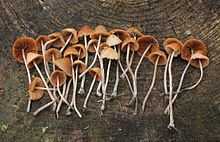Pholiotina
| Pholiotina | |
|---|---|
 | |
| Pholiotina rugosa | |
| Scientific classification | |
| Kingdom: | Fungi |
| Division: | Basidiomycota |
| Class: | Agaricomycetes |
| Order: | Agaricales |
| Family: | Bolbitiaceae |
| Genus: | Pholiotina Fayod (1889) |
| Type species | |
| Pholiotina blattaria (Fr.) Fayod (1889) | |
Pholiotina is a genus of small agaric fungi. It was circumscribed by Swiss mycologist Victor Fayod in 1889.[1]
Taxonomic details
The genus Pholiotina is defined as small thin Mycena-like mushrooms, with an hymenoderm pileipellis, a dry cap surface, cystidia that are sub-capitate to blunt, and spores which are rusty brown in deposit. Spores of mushrooms of this genus are thick walled, smooth and have a germ pore.
Some authors consider Pholiotina part of the genus Conocybe. The two genera can be distinguished microscopically: Pholiotina contains a differentiated central zone called a mediostratum that is lacking in Conocybe. Additionally, Pholiotina species have cystidia with rounded to tapered tips, compared to the enlarged, globular cystidial tips of Conocybe.[2]
In a 2007 publication, Hausknecht and Krisai-Greilhuber devised an infrageneric classification that includes the sections Piliferae and Vestitae, and the series Aeruginosa, Aporos, Appendiculata, Brunnea, Coprophila, Filipes, Keniensis, Mairei, Pygmaeoaffinis, Resinosocystidiata, Sulcata, Teneroides, Utriformis, and Vexans.[3]
Species

Pholiotina rugosa is the most commonly known species of this genus, although in most field guides this species is known as Conocybe filaris, which is a taxonomic equivalent.
- Pholiotina aberrans[4]
- Pholiotina aeruginosa
- Pholiota alnicola
- Pholiotina aporos
- Pholiotina arnoldsii
- Pholiotina arrhenii
- Pholiota astragalina
- Pholiotina atrocyanea[5]
- Pholiotina cyanopus[4]
- Pholiotina dasypus
- Pholiotina exannulata
- Pholiotina filaris[4]
- Pholiotina flava[6]
- Pholiotina gracilenta
- Pholiota gummosa
- Pholiota lenta
- Pholiota lubrica
- Pholiotina indica
- Pholiotina intermedia
- Pholiotina keniensis[7]
- Pholiotina mairei[4]
- Pholiotina nemoralis
- Pholiotina novae-zelandiae
- Pholiotina parvula[8]
- Pholiotina plumbeitincta[6]
- Pholiotina smithii
- Pholiota spumosa
- Pholiotina sulcata[9]
- Pholiotina vestita[4]
References
- ↑ Fayod VF. (1889). "Prodrome d'une histoire naturelle des Agaricinés". Annales des Sciences Naturelles, Botanique. VII (in French) 9: 181–411 (see p. 359).
- ↑ Mukerji KG. (2010). Taxonomy and Ecology of Indian Fungi. I. K. International Pvt. p. 204. ISBN 978-93-8002-692-3.
- ↑ Hausknecht A, Krisai-Greilhuber I. (2007). "Infrageneric division of the genus Pholiotina – a classical approach". Österreichische Zeitschrift für Pilzkunde 16 (1): 133–45.
- ↑ 4.0 4.1 4.2 4.3 4.4 Prydiuk MP. (2006). "New records of Pholiotina species in Ukraine". Czech Mycology 58 (3–4).
- ↑ Esteve-Raventós F, Hausknecht A, Rejos FJ. (2007). "Pholiotina atrocyanea, spec. nova, and three other rare Pholiotina species (Bolbitiaceae, Agaricales) from Spain". Österreichische Zeitschrift für Pilzkunde 16 (1): 117–26.
- ↑ 6.0 6.1 Hausknecht A, Krisai-Greilhuber I, Voglmayr H. (2004). "Type studies in North American species of Bolbitiaceae belonging to the genera Conocybe and Pholiotina". Österreichische Zeitschrift für Pilzkunde 13: 153–235 (see pp. 180, 212).
- ↑ Hausknecht A. (2007). "Beiträge zur Kenntnis der Bolbitiaceae 11. Unberingte Arten der Gattung Pholiotina". Österreichische Zeitschrift für Pilzkunde (in German) 16 (1): 35–116.
- ↑ Bon M. (1991). "Novitates - Espèces "galéro-naucorioides", stat. et comb. nov.". Documents Mycologiques (in French) 21 (83): 37–40.
- ↑ Arnolds E, Hausknecht A. (2003). "Crepidotus cristatus, a new yellow species from the Netherlands". Persoonia 18 (2): 239–52.